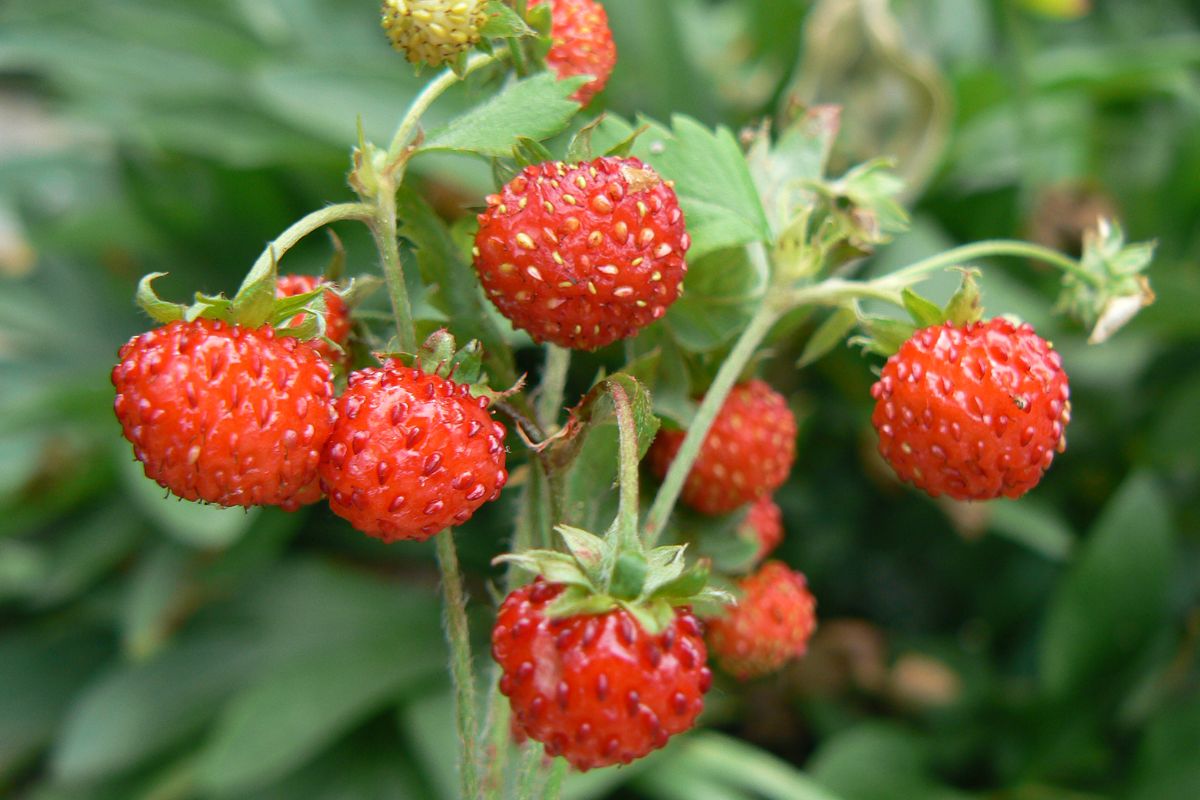Have you ever gone on a nature walk and found a patch of wild strawberries? If so, it can be tempting to grab a few and pop them in your mouth. But are wild strawberries safe to eat or are they poisonous?

In this article, we’ll discuss the difference between strawberries and wild strawberries, whether wild ones are good to eat, how to identify them from mock strawberries, how to safely consume them, and where you can find them. So join us as we explore the tasty world of wild strawberries!
Strawberries And Wild Strawberries
The main difference between strawberries and wild strawberries is their size and shape. Regular strawberries are large and plump, while wild ones tend to be smaller and more cylindrical in shape.
Wild strawberries also grow over the ground instead of as a bush like regular strawberries. You’ll also notice that the color of the fruit differs. Wild strawberries usually have a darker red hue than their cultivated counterparts.
In addition, wild strawberry plants typically grow to about 3 inches tall, compared to the larger varieties which can reach up to 12 inches in height. Finally, wild strawberries have smaller seeds that are much less noticeable than those found on regular varieties.
Can You Eat The Wild Ones?
Wild strawberries are a delicious and nutritious treat that can be found growing in the wild across many countries. You’ll be pleased to know that not only are they safe to eat, but they are often sweeter and more flavorsome than store-bought strawberries.
Wild strawberries contain many essential vitamins and minerals like vitamin C, magnesium, iron, folate, and potassium. Eating them can help reduce inflammation while providing antioxidants to your body.
So next time you come across wild strawberries on your walk or hike, don’t hesitate to take a few home for a healthy snack, or eat while you hike for a delicious energy hit!
Wild Strawberries By Type
As we’ve mentioned wild strawberries can be found growing in many different habitats across North America and other countries. The most common types of wild strawberries are:
- Virginia Wild Strawberry
- Beach/CoastSand Strawberries
- Woodland Strawberry
The Virginia Wild Strawberry has leaves that are medium-light green and shaped like a three-leaf clover. These plants bear small, red berries that are full of flavor.
Beach/Coast/Sand Strawberries have dark, shiny leaves plentiful on the vine and also small, red berries but not as flavorful as Virginia Wild Strawberry.
The Strawberries found along beach areas have dark and shiny leaves, which are plentiful on the vine. They also have small, red berries, but they are not as flavorful as Virginia Wild Strawberries. Woodland strawberries are bigger than other types. They grow in shady places and have white flowers.
You can safely consume all these wild strawberry varieties and they are a great addition to your diet, and the best bit is, they are completely free, so why not take a basket along with you and stock up if you know you will encounter these tasty berries.
Are Mock Strawberries Safe To Eat?
Mock strawberries are also a type of wild strawberry and are small red berries that have a similar look and taste to regular strawberries. While they may not have the same flavor and texture of regular strawberries, they are safe to eat.
Mock strawberries contain some of the same nutrients and antioxidants found in regular strawberries, including vitamin C, fiber, and potassium. They can be eaten fresh or used as a substitute in recipes that call for regular strawberries.
How To Identify A Wild Strawberry From A Mock Strawberry?
Identifying wild strawberries from mock strawberries can be tricky, but there are a few key indicators to look for. Wild strawberries have dark green leaves that resemble three-leaf clovers, and the fruits are typically small and red.
Mock strawberries have much lighter green leaves with five leaflets, and their fruits are usually larger and yellow. Additionally, wild strawberry fruits tend to be juicy and sweet while mock strawberry fruits are dry and bitter.
When picking wild strawberries, it’s important to make sure they’re ripe before consuming them as unripe berries may cause digestive issues. To check if they’re ripe, gently squeeze the berry in your hand – if it is soft enough to leave an imprint of your finger then it is ready!
Also remember that when harvesting wild strawberries you should never pick all of them off one plant as this will prevent new growth in the future.
Identifying Your Strawberries

Before eating wild strawberries make sure to correctly identify them by examining how the berry feels and what it looks like. It could be useful to invest in a book about the different varieties to help you figure it out. To check ripeness simply squeeze the berry and if it’s soft it’s ripe and ready.
Where To Find Wild Strawberries?
Wild strawberries can be found growing in many different areas. They thrive in areas with dry, chalky, loamy, and rich soil and prefer temperate summers.
Look for them in yards or along walking paths, as well as sunny areas of woods or among ferns on the forest floor. When you come across a wild strawberry plant, search around it to find additional berries.
How Can You Tell If Wild Berries Are Poisonous?
We now know that wild (ripe) strawberries are safe to consume but what about berries? Wild berries can be found in many places, but it’s important to know how to tell if they are poisonous or safe to eat. The best way is to properly identify the berry and its plant.
Look for spines on the fruit, a hairy stem, or milky sap oozing from anywhere as these are all signs that the berry is likely poisonous. Note the color and texture of the fruit and take note of the leaves and roots of the plant.
It’s also helpful to consult a scientific web source or book on berry identification, especially if it’s something you are interested in. As an additional safety measure, you can rub a bit of juice from the berry onto your skin and wait five minutes before checking for any irritation.
This will help ensure that you don’t accidentally ingest any wild berries that may be poisonous.
Best Ways Of Ways Of Eating Strawberries & Berries
One of the best ways of eating strawberries and non-poisonous berries is to simply enjoy them raw. This is the best way to enjoy this sweet, juicy fruit, without any added sugar or artificial flavors.
Eating raw strawberries is a great way to get a healthy dose of antioxidants, as well as a sweet snack or dessert. Another great way to enjoy strawberries is to make them into a smoothie.
A strawberry smoothie can be made with fresh or frozen strawberries, yogurt, and other ingredients like banana or honey. This is a great way to get your daily dose of fruit and can be a healthy, refreshing snack or meal.
Smoothies can also be a great way to sneak in some extra fruits and vegetables into your diet especially if you aren’t too keen on them. Finally, you can also bake with strawberries. Baked goods like muffins, cakes, and pies are all great ways to enjoy strawberries.
This can be a great way to use up any extra strawberries you have on hand, and baking with strawberries can add a delicious sweetness and natural flavor to any recipe.
How To Grow Wild Strawberries?
Wild strawberries are a delicious and easy to grow fruit that can be found in many gardens and landscapes. Growing wild strawberries is relatively easy and can be done in a few simple steps.
- The first step to growing wild strawberries is to select a suitable site for the plants. Wild strawberries prefer full sun and well-drained soil. The plants should be planted in a location that is not prone to standing water or flooding.
- Once the site has been selected, the wild strawberry plants should be planted in the spring. The plants should be spaced out at least six to eight inches apart. After planting, the strawberries should be watered regularly and the soil should be kept moist.
- Once the plants are established they will require little maintenance. Fertilizer should be applied in the spring and early summer. It is also important to keep the area around the plants free of weeds to prevent competition for water and nutrients.
- If the strawberries are planted in a location with high deer pressure, a fence may be necessary to protect the plants. In the early summer, the strawberry plants will produce white flowers followed by the small red berries.
The berries should be picked when they are fully ripe for the best flavor. Wild strawberries are a great addition to any garden and will produce a delicious crop of fruit each year.
Where To Find Wild Strawberry Plants To Place In Your Backyard?
Wild strawberry plants can also be purchased from nurseries and garden centers. When purchasing wild strawberry plants, look for ones with healthy, green foliage and no signs of disease or insect damage.
When transplanting wild strawberry plants, be sure to follow the instructions carefully, as the plants can be sensitive to their new environment. Dig a hole that is large enough for the roots of the plant, and make sure to water the plants regularly.
With proper care, your backyard will be filled with delicious wild strawberries in no time!
Learning About Strawberries
The best way to learn about strawberries is to start by researching them. Look up information about the different types of strawberries, their nutritional benefits, and their history.
It is also helpful to watch videos on how to properly prepare and store strawberries. Additionally, consider reading books or articles about the different varieties of strawberries and their cultivation.
Once you have done some research, the best way to learn about strawberries is to get hands-on experience with them. Visit a local strawberry farm or pick your own strawberries at a farm stand.
Conclusion
Wild strawberries are a delicious and nutritious fruit that is easy to grow in many gardens. The berries can be enjoyed raw, cooked, or baked into a variety of recipes.
Before eating any wild berry it is important to identify the plant correctly and make sure it is safe to eat. Once identified, wild strawberries can be enjoyed as a healthy snack or addition to any recipe.
- How To Reheat A Cheesesteak - November 5, 2023
- What Are Three Must Have Kitchen Knives? - September 22, 2023
- How To Protect Edges Of Pie Crust - June 15, 2023








